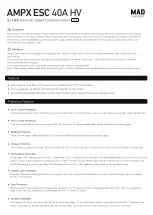
Page 3
RVS-RCS Installation Guide
controllers receive an occupied state telegram before their occupancy timer expires,
the lights will remain on.
PIR Motion Detection
The sensors use a PIR sensor element that detects motion by measuring the infrared energy
emitted by objects. The sensors are calibrated to detect the temperature range of the
human body. The sensor has a lens that breaks the viewing angle of the sensor into zones
(movement zones), infrared energy moving in and out of a zone is how the occupied state is
defined. The amount of movement that triggers the sensor is dependent upon the density of
the zones and where the motion takes place. A higher density of zones means smaller motion
will trigger the sensor.
For detection of small motion (typing, drinking from a coffee cup), use the A lens which
has more movement zones. Place the sensor close to the location where the motion may
occur.
The sensor comes with a sticker that can be applied to the lens to mask off areas where
motion detection is not desired. Refer to the Lens Mask section of this guide.
An LED under the lens will blink once every 100 seconds when the sensor is detecting
motion. Additionally, the LED color indicates the status of the battery when applicable,
see the following table.
LED Color
Battery Status
Red
No battery or weak
Amber
50% discharged
Green
Full charge
Mounting the Sensor
The mounting location of the sensor is important as this will directly affect the receivers’
reception of the telegrams. Before installing, refer to the sections in the guide detailing
the installation of wireless devices, layout tips and test operation modes.
i
Note:
Do not locate the sensor near forced air vents as hot moving
air may cause the sensor to false trigger. Leave at least 4’ (1.2
m) minimum between air vents and the sensor. The PIR sensors
cannot detect occupancy through solid objects including items
placed by a tenant, such as file cabinets or shelves. Use the dual-
tech models in these applications.
Lens B: use for large motion detection or larger rooms.
8ft/2.4m
30ft/9.1m
20ft/6m
10ft/3m
0
10ft/3m
20ft/6m
30ft/9.1m
10ft/3m
0
8ft/2.4m
15ft/4.5m
10ft/3m
5ft/1.5m
0
5ft/1.5m
10ft/3m
15ft/4.5m
10ft/3m
0
8ft/2.4m
15ft/4.5m
10ft/3m
5ft/1.5m
0
5ft/1.5m
10ft/3m
15ft/4.5m
10ft/3m
0
Lens A: use for small motion detection or small rooms.


























